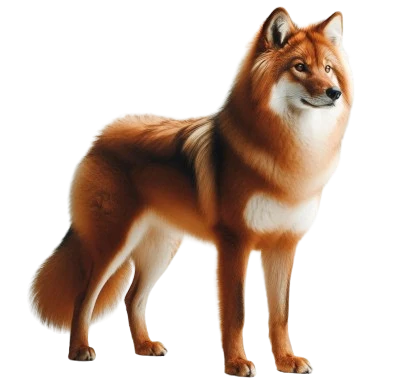
The Ethiopian Wolf (Canis simensis) is one of the rarest and most endangered species in the world. This endemic predator lives in the Ethiopian mountains and plays a vital role in the region's alpine ecosystems.
The Ethiopian Wolf is a medium-sized canid, measuring about 60 cm at the shoulder and weighing between 11 and 20 kg. Its fur is typically tawny with lighter shades on the chest and legs. It has a relatively small head, large ears, and keen eyes, adapted to its mountainous environment.
The Ethiopian Wolf (Canis simensis) belongs to the Canidae family, which also includes species like domestic dogs, foxes, and coyotes.
Endemic to the Ethiopian mountains, the Ethiopian Wolf is extremely vulnerable, with a population of fewer than 500 individuals, primarily due to habitat loss and diseases transmitted by domestic dogs.
The Ethiopian Wolf mainly inhabits the highlands of Ethiopia, at altitudes between 3,000 and 4,500 meters. This mountainous habitat consists of heathlands and alpine meadows, where the species finds its primary prey, such as rodents like hares and small mammals.
Ethiopian wolves are solitary animals or live in small packs. Their social structure is less complex than that of the Gray Wolf, but they are highly territorial and use vocalizations to define their hunting areas. They are discreet and avoid areas where humans are present.
The diet of the Ethiopian Wolf mainly consists of small mammals, particularly rodents like hares, field rats, and other small animals. They generally hunt alone or in small groups and also scavenge when carcasses are available.
The Ethiopian Wolf is classified as critically endangered by the IUCN, mainly due to habitat degradation, diseases transmitted by domestic dogs, and hunting. Conservation efforts, including population monitoring and disease management, are underway to protect this unique species.
The Ethiopian Wolf belongs to the genus Canis, which also includes the African Golden Wolf (Canis anthus). These two species share unique characteristics within the Canid family, notably their adaptation to varied environments and their complex social behavior.
Observing the Ethiopian Wolf in its natural habitat is a rare and valuable experience. Here are some tips to minimize disturbances and ensure a respectful observation.
By following these recommendations, you will contribute to the preservation of the Ethiopian Wolf while enjoying a unique adventure in the Ethiopian highlands.